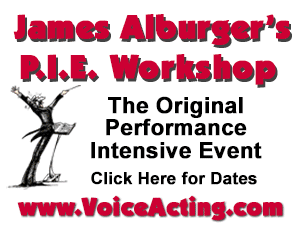|
'Just Give Us Five In A Row' ...
Prepare By Practicing Variety
By Randye Kaye
Voice Actor & Coach
 Sooner or later, as a voice over talent, you’re going to hear this direction: Sooner or later, as a voice over talent, you’re going to hear this direction: “OK now, just give us five in a row.”
This usually happens when you’re at the opening line or closing line of the copy, but your client may also ask for it anywhere else.
Why? Usually one of two reasons:
WE ALL GET STUCK
Even when you’re in your home studio, and the “director” is – well, you - you still may find that you need to open up to create more possible ways to approach the words in front of you.
We all get stuck now and again!
Part of your job as a VO professional is to be flexible, imaginative, relaxed enough to go in a different direction, and professional enough to maintain the change when necessary.
So – your practice routine should always include finding ways to open yourself up to more variety.
PRACTICING VARIETY
How to find the variety? The key is to be prepared, by practicing variety.
There are two ways to approach this, using both sides of your brain, and they ultimately function together. These are:
USE YOUR BRAIN!
Huh? What about my brain?
Yeah, this is simplified.
But basically we need to access both sides in practice sessions - the right side, where imagination, whole concepts and emotion are key - and the left, which is more about separate ideas, organization, logical thinking.
Think about learning to play the piano, for instance.
Left brain: correct finger positions, practicing scales, posture, learning the notes.
Right brain: feel the music. Let it flow through you. Trust the techniques you’ve practiced, let them go, and be the music.
VOICE OVER EXERCISES
So – here are some exercises to use when practicing variety.
For these exercises, use any phrase or sentence, such as:
Right Brain:
Imagination.
Read the above phrase using ...
1. Different emotional states.
These are usually adjectives, such as: Angry. Sad. Disappointed. Frightened. Disgusted. Perky. Secretive.
To make these work, it helps to imagine the reason you might feel this way. What happened to make you feel that emotion?
Actors call this “the moment before.”
Imagine who you are mad at, for instance, and why. No piece of copy comes out of the air. There is always a reason to keep talking.
You can “color” an entire copy section with the tone change, or just infuse one word with it. For example, “delicious,” or “anguish” – for a non-pitch path to emphasis.
2. Different gestures/body language.
Your brain has spent a lot of years associating emotions and vocal elements with certain gestures.
If you throw something across the room, I dare you to sound relaxed and calm while you do it.
I always ask my classes to try to be the voice of the Wicked Witch of the West without scrunching up their nose, stooping over, and making those crunched-up witch hands.
There's never enough commitment to the reads without the body to go along with it.
Try it sometime. With this phrase, just use your already-strong connections and try a few gestures:
3. Different thoughts.
Actors call this subtext. If you say “I hate you” while thinking “I love you”, or vice versa, you’ll see what I mean.
Try some of these thoughts:
4. Different intentions.
As in, “But what’s my motivation?”
It, too, changes everything.
These are usually verbs, something you are trying to do, something you want. For example, you want to:
5. Different characters for you and/or your listener.
Some of this comes with a change in body language. But remember: we speak differently in different roles in our own lives - employee, spouse, best friend, child, sibling, co-worker.
Are you reading as a stuffy professor? Straight-laced CEO? Friendly neighbor?
We speak in different tones to different listeners, too - a baby, a boss, and peer, a young child, a teenager, the President.
Let this natural variety work for you when reading copy by using your imagination.
Who are you talking to, and why?
RECORD YOUR PRACTICES
OK, you get the picture. Some imagination techniques put everything else into gear without overthinking.
Record yourself practicing these reads and listen back to see if you fully committed to the changes your imagination wanted to make.
Stuck for ideas? There are excellent lists of intentions, characters, etc. in any good improvisation book. Or take a class!
Left Brain:
Conscious Control
Practice these exercises ...
Then there's the left side of the brain, where thinking is more linear.
Here's where conscious control of the elements like tempo, pitch, phrasing and volume can also help you find ways to vary your reads.
1. Pitch. Try:
2. Phrasing/Pausing.
Sentences are made up of ideas, usually in phrases, not just words.
In natural conversation, we stop to think. We stop to absorb. Try:
3. Tempo.
In real life, tempo is more like an accordion.
We speed up, slow down, we change mid-sentence.
Also, in VO, you may need to hit a particular time. Tempo change can change the energy. Try:
4. Volume.
Just be sure you always treat the microphone as if it’s someone’s ear!
5. Emphasis. Try:
TECHNIQUE EXERCISES
For excellent technique exercises, I recommend the Industry Guidebook from Edge Studio, Chapter 4. Just make sure to apply the exercises to other pieces of copy once you’ve used the examples in the book.
You can find this at www.edgestudio.com. (Editor's note: Mention VoiceOverXtra when you call, for a special discount on training there.)
And, yes, “the possibilities are endless.” There's so much more, but that's what coaching - and focused practice - is all about.
GO FOR 20
Meanwhile, jump in and aim for variety. Try 20 in a row.
See what works and what doesn't.
This business is all about play, and practice brings confidence. So – play!
That’s practice. Then, when you’re on the job, these skills will be there for you without overthinking.
By approaching copy from both sides of your brain you'll find your own ways to increase your skills and your ability to communicate with your client.
Happy clients are a good thing!
ABOUT RANDYE ...
Randye Kaye has over 20 years of experience as a voice talent, stage/TV/film actress, and radio personality, with a long list of major clients including Priceline.com, Dannon, Kyocera, Big Lots, Burger King, Executone, Continental Airlines, MISTO, Toshiba, Verizon, and many more. She provides a trustworthy and intelligent voice for countless websites, e-learning courses, phone systems, on-hold messages, promos, industrial narrations, audiobooks (children, adults), science/medical/technical instruction, video games, travel/real estate/museum tours, and live events. She is also a voice over coach with Edge Studio in New York City and Connecticut.
Email: randye@randyekaye.com
Web: www.randyekaye.com
|
|
|
Get your bi-weekly dose here ... all things VO!
For essential voice-over business strategies
On Michael Langsner's Voice-Over Roadmap Podcast
Inspiring interviews help your VO career
As of the NEW website launch, 03/22/2012










Thanks!
Randye
www.randyekaye.com
Such good reminders, and like Pamela, I too will print this article and make a concerted effort to practice its pearls of wisdom. See you at Edge!
Best, Debbie
treat the mic as if it's someone's ear ...
That is so cool ... and such a lovely insight.
I shall never forget that one.
Alan Sklar
JUSTIN HIBBARD
JustTheVoice Imaging & Productions - Los Angeles
I'm working on a series of you-tube videos to illustrate these - and was even brave enough to record episode #1 in bad lighting and with no make-up! my you-tube channel is "Randye Kaye, Voice Talent", and there are also some samples of videos I have voiced, mostly in the warm/friendly/narrative tone :)
Thank you for sharing some very practical and challenging advice/coaching! This will keep me busy for a loooong time. It'll be great to have this "under our belts" when a client asks for "20," and without batting an eye....we just do it!
Sincerely,
Mike
I learned this technique many years ago from one of my coaches and it never fails to bring out the real variety that we possess inside of each of us. And, it's so easy to forget what resides inside of us just waiting to get out, if WE would just get out of the way. It's so easy to get stuck in a monotone delivery or style.
Open up & breath this life back into your delivery.
Thanks, Randye!
Thanks for the super article. You've confirmed what I was taught. I had an excellent VO coach that started each of my sessions with a warm up that featured a number of phrases. I was to act each phrase differently, and I had to use a different "voice" each time. It did wonders in expanding my range and I continue to do it as part of my daily vocal exercises. It really does make a difference.